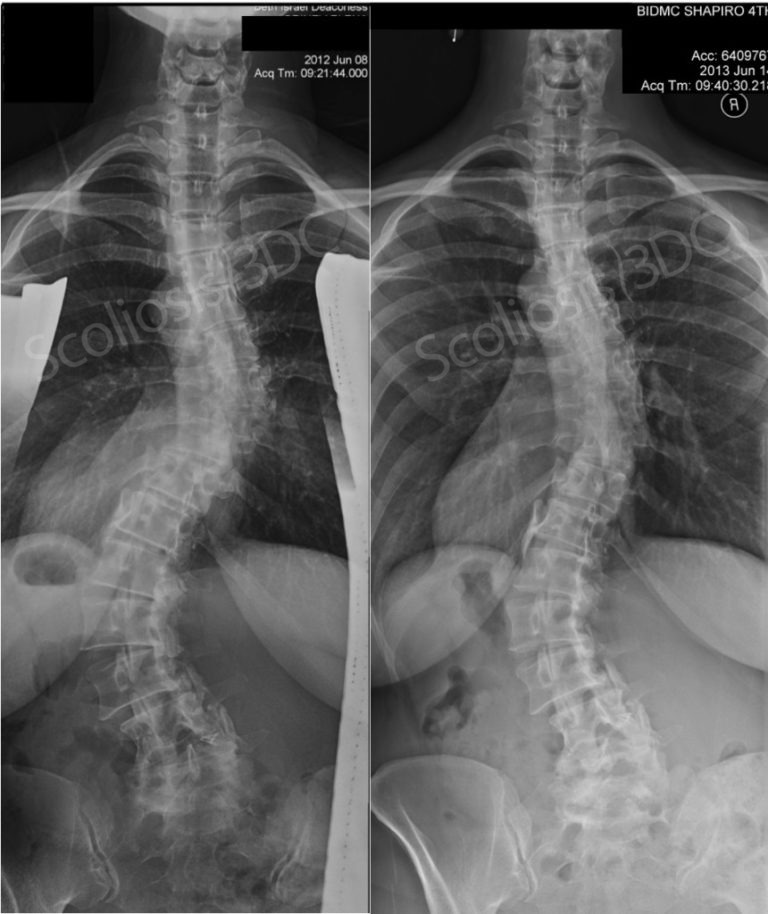 Adult Reduces Scoliosis with Schroth Method
Adult Reduces Scoliosis with Schroth Method
E.G. is a 47-year-old female with a scoliosis diagnosed in adolescence. She was x-rayed on June 8, 2012 at 9:21 AM. E. decided she wanted to find a way to manage scoliosis proactively. She found our website and called.
E.’s initial evaluation was in August, 2012. She began Schroth Method instruction the following September attending sessions sporadically over a few months. She concluded thirteen program hours before her follow-up x-ray. E.’s supportive husband accompanied her to each session. She reported scoliosis exercise compliance four times weekly. E. is a busy businesswoman with children and travels frequently.
E. had another set of x-rays at the Boston hospital where she has scoliosis x-rays taken annually. The image on the right was taken one year after the image on the left on June 14, 2013 at 9:40am, the same hour of the morning as the x-ray taken the year before. We mention the time since there is a study which notes diurnal variation as a reason for discrepancies in scoliosis x-ray readings (note – that study measured adolescent x-rays), Beauchamp et al1.
E.’s before Schroth June, 2012 x-rays (left) indicated a 55º lumbar Cobb angle (measured at 60º at the hospital, but our initial measurement was 55º) and a thoracic spinal curvature of 44°. E.’s after Schroth June, 2013 x-ray (right) measured 43º lumbar and 39º thoracic. E. reported her doctor’s reaction as “shocked.” She said he admitted had never seen anything like her result before. She told me he remeasured the x-ray repeatedly and had other physicians confirm the Cobb angle measurements. The measurements reported here are oursi since she did not provide the report, just the images on disc. E.’s doctor asked what she had done differently in the past year. She told him she had learned and practiced the Schroth method and also incorporated what she learned during her daily routine. He wrote it down since he had never heard of the Schroth Method.
E.’s 12º decrease in lumbar curvature is considered a reduction. Her 5º reduction in the thoracic spine is technically unchanged since it is within the 5º margin of error noted when comparing scoliosis Cobb angle measurements. However, her thoracic spine improving toward the midline and with continued work, perhpas she could potentially reduce her thoracic curve even more now that we seen what she has accomplished with her lumbar spine.
An adult has now accomplished, without question, what the scoliosis community has been told is unattainable. E. can get in line with our good friend, Martha Hawes, PhD., author of “Scoliosis and the Human Spine.” Read Martha’s account of her story in the article, Reversal of childhood idiopathic scoliosis in an adult, without surgery: a case report and literature review2.
E.’s case is promising. She is one of only two adults instructed here at Scoliosis 3DC who had, at that point, chosen to be re-x-rayed. Another adult patient with idiopathic scoliosis was re-x-rayed a couple of years ago and reported a 6º reduction but didn’t send x-ray images. Reporting results for adults is a challenge in terms of comparing Cobb angles since most adults with scoliosis feel they have been x-rayed to the limit and decline. We understand. We want our adult patients to come to us with reasonable expectations with a focus on pain reduction, stabilization, improving asymmetries (postural appearance), breathing easier, without stressing about the numbers on an x-ray. Most adults are pleased when they experience an improved quality of life and realize they are finally on the right track after years of frustration. The need for additional x-rays doesn’t seem necessary to many which we get. Many thanks to E. for tracking her spine and sharing her x-ray results. They are very encouraging for those with idiopathic scoliosis – adolescent or adult. People want to know does the Schroth Method work? Absolutely.
1 Beauchamp, Marc MD; Labelle, Hubert MD; Grimard, Guy MD; Stanciu, Constantin MD; Poitras, Benoit MD; Dansereau, Jean PhD 1993 Spine 18: 1581-1583. Diurnal Variation of Cobb Angle Measurement in Adolescent Idiopathic Scoliosis
2Reversal of childhood idiopathic scoliosis in an adult, without surgery: a case report and literature review. William J Brooks, Elizabeth A Krupinski and Martha C Hawes*

